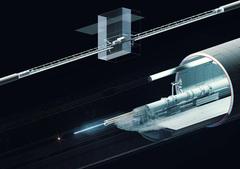Artist's impression of the ALPS II experiment. Image: DESY, Scicom Lab
The international ALPS II (“Any light particle search”) collaboration installed the first of 24 superconducting magnets today, marking the start of the installation of a unique particle physics experiment to look for dark matter. Located at the German research centre DESY in Hamburg, it is set to start taking data in 2021 by looking for dark matter particles that literally make light shine through a wall, thus providing clues to one of the biggest questions in physics today: what is the nature of dark matter?
“It is very exciting to see the project that many of us have been working on for so many years finally taking shape in the tunnel,” ALPS-II spokesman Axel Linder from DESY said. “When installation and commissioning proceed as planned we will be able to start the search in the first half of 2021.”
Dark matter is one of the greatest mysteries in physics. Observations and calculations of the motion of stars in galaxies, for example, show that there must be more matter in the Universe than we can account for with matter particles known today. In fact, dark matter must make up 85 % of all the matter in the Universe. However, currently we don’t know what it is. But we know that it does not interact with regular matter and is essentially invisible, so that it is called “dark”.
There are several theories that try to explain the nature of dark matter and the particles it may consist of. One of these theories states that dark matter consists of very light-weight particles with very specific properties. One example is the axion which was originally postulated to explain aspects of the strong interaction, one of the fundamental forces of nature. There are also puzzling astrophysical observations such as discrepancies in the evolution of stellar systems, which might also be explained by the existence of axions or axion-like particles.
This is where ALPS II comes in. It is designed to create and detect those axions. A strong magnetic field can make axions switch to photons and vice versa. “This bizarre property was already exploited in the initial ALPS I experiment which we ran from 2007 to 2010. Despite its limited size, it achieved the world-wide best sensitivities for these kinds of experiments,” said Benno Willke, the leader of the ALPS and of the laser development group at the Max Planck Institute for Gravitational Physics (Albert Einstein Institute) and at the Institute for Gravitational Physics at Leibniz Universität of Hannover.
ALPS II is being set up in a straight tunnel section of DESY’s former particle physics accelerator HERA. Twenty-four superconducting accelerator magnets, twelve on either side of a wall, house two 120-metre-long optical cavities. A powerful and intricate laser system produces light that is amplified by the cavity inside the magnetic field and will, to a very small fraction, convert into dark matter particles. A light-blocking barrier – a wall – separates the second compartment of ALPS II, but this wall is no hurdle for axions and similar particles that can easily pass through it. In the second cavity dark matter particles would convert back into light. The tiny signal will be picked up by dedicated detection systems.
The more than 1,000-fold improvement in sensitivity of ALPS II is made possible by the increased length of the magnet strings but also by significant advances in optical technologies. “These advances emerged from the work on gravitational wave interferometers such as GEO600 and LIGO, and nicely show how technological advances in one area enable progress in others,” said Co-Spokesperson Guido Mueller from the University of Florida in Gainesville.
ALPS II is also an example of recycling in research: it does not only reuse a stretch of tunnel that once housed DESY’s flagship particle accelerator, but it also reuses the very magnets that drove protons around the ring until 2007. These magnets needed to be reengineered to fit the ALPS purposes: the slight bend needed in an accelerator ring had to be removed to allow photons to propagate through them.
The ALPS II collaboration consists of some 25 scientists from these institutes: DESY, the Max Planck Institute for Gravitational Physics (Albert Einstein Institute) and the Institute for Gravitational Physics at Leibniz Universität of Hannover, the Johannes Gutenberg-Universität Mainz, the University of Florida in Gainesville, and Cardiff University. Beyond that, the collaboration is supported by partners worldwide like the National Metrology Institute (PTB) in Germany and the National Institute of Standards and Technology in the USA. The experiment is mainly funded by DESY, the Heising-Simons Foundation, the US National Science Foundation, the German Volkswagen Stiftung and German Research Foundation (DFG).
At DESY, ALPS II might be just the first experiment within a new strategic approach to tackle dark matter. “International collaborations are preparing the IAXO experiment to search for axions emitted by the Sun as well as the MADMAX detector, which will look directly for axions as constituents of the local dark matter surrounding us”, explained Joachim Mnich, DESY’s director for particle physics.
Partner institutes and funding agencies:
Max Planck Institute for Gravitational Physics (Albert Einstein Institute)
Institute for Gravitational Physics at Leibniz Universität of Hannover
Johannes Gutenberg-Universität Mainz
University of Florida in Gainesville
Cardiff University
Physikalisch-Technische Bundesanstalt (PTB)
National Institute of Standards and Technology (NIST)
Heising-Simons Foundation
National Science Foundation
Volkswagen Stiftung
Deutsche Forschungsgemeinschaft (DFG)








